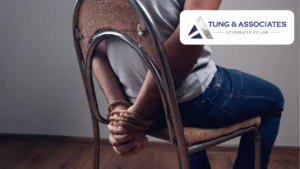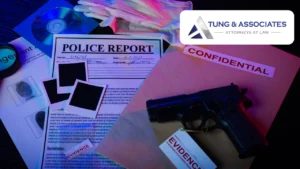Former prosecutor dedicated to defending Pasadenans facing criminal charges. Call today to start your defense.

Home » Pasadena Kidnapping Lawyer Near Me
Attorney Antony Tung has spent more than a decade defending people in Pasadena from violent-felony accusations, including complex kidnapping cases. Our office sits one block from Old Town at 790 E. Colorado Blvd., 9th Floor, putting us minutes from the courthouse and the Pasadena Police Department.
Kidnapping is always a felony in California: “simple” kidnapping under Penal Code § 207 carries 3, 5, or 8 years in state prison, and aggravated kidnapping under § 209 can mean life. Because each conviction is also a “strike,” a second strike doubles the sentence and a third can trigger 25-to-life. We make sure every client understands these stakes and the defenses that can prevent them.
Our Pasadena criminal defense lawyers move fast – contact with the police and prosecutors often starts within hours of an arrest, and we answer the phone 24/7 at (626) 416-4668 so no one faces that first interview alone. By calling us immediately, you give us time to preserve evidence, argue for reasonable bail, and begin negotiating before charges solidify.
Free Consultation: Call (626) 416-4668 or complete our confidential form now.
“Antony Tung is the best lawyer I’ve ever worked with. His team is incredibly efficient and always kept me in the loop. They handled my case with the utmost professionalism and achieved great results.” – Moses Seniceros
California law defines kidnapping with precision. Penal Code § 207(a) states that moving another person a “substantial distance” without consent by force, fear, or fraud is a felony. “Substantial distance” is judged by risk and inconvenience to the victim, not feet or yards, so even crossing a parking lot may qualify.
Why does the statute read this way? Legislators wanted to capture any forced movement that increases danger – for example, dragging someone from a public sidewalk into a car removes witnesses and heightens harm. Because the offense automatically meets the “violent felony” definition, it also triggers the Three-Strikes Law and can double or triple future sentences.
Simple kidnapping under § 207 carries 3, 5, or 8 years in state prison. Aggravated kidnapping under § 209 adds factors such as ransom, bodily harm, a victim under 14, or kidnapping during another felony like robbery or carjacking. Those enhancements raise exposure to life in prison, sometimes without parole. Understanding these categories early lets our attorneys target weaknesses – for example, proving the movement was trivial or that no intent to ransom existed can collapse the aggravated allegation and reduce potential time by decades.
California separates kidnapping into several distinct offenses so prosecutors can match punishment to risk and intent. Knowing which statute the district attorney files controls everything from potential sentence to available defenses, so we make identifying the correct charge our first task for every new client.
Simple kidnapping involves moving any victim a substantial distance without consent by force, fear, or fraud. Penalties are 3, 5, or 8 years in state prison, plus a strike on the person’s record. Because the core element is movement, showing the distance was trivial – or that the alleged victim agreed to go – can defeat the charge entirely.
Moving or concealing a child younger than 14 raises punishment to 5, 8, or 11 years under § 208. When a parent without legal custody removes a child, prosecutors may instead use child abduction statutes (§ 278/278.5), which still allow up to 4 years but recognize the family context. We often argue good-faith parental intent or a mistaken custody belief to seek dismissal or reduced charges.
Kidnapping escalates to aggravated when it is committed for ransom, reward, extortion, robbery, sexual assault, or when the victim suffers great bodily injury. Conviction can mean life in prison with the possibility of parole, and prosecutors frequently add firearm or GBI enhancements that raise stakes even higher. Our attorneys scrutinize motive evidence – if no extortion demand exists, the aggravated allegation can collapse.
Holding a driver or passenger while stealing a vehicle triggers § 209.5 and can lead to life without parole. Because this charge hinges on whether the victim’s forced movement was merely incidental to the carjacking or substantially increased risk, we often bring accident-reconstruction or route-analysis experts to show the movement was minimal, aiming to downgrade the case to robbery alone.
Kidnapping sentences escalate quickly because lawmakers treat forced movement as an extreme danger to public safety. Even a first-time offender with no record can face a decade or more behind bars, and every conviction becomes a “strike” that doubles or triples future sentences.
Possible Consequences at a Glance
Why highlight these numbers? Clear stakes help us negotiate. When prosecutors know we can explain to a jury why a movement was minor or why no ransom was intended, they lose leverage to pursue the harshest terms.
An arrest for kidnapping moves fast from handcuffs to the Pasadena Police jail and then to the Pasadena Courthouse within 48 hours. The first decision – whether to talk – often makes or breaks a defense.
Why Act Quickly?
The District Attorney’s Pasadena branch files violent-felony charges aggressively. When we present exculpatory evidence or mitigation early, prosecutors sometimes reconsider aggravated counts before the case hardens, saving clients years of exposure.
A strong defense strategy dismantles the prosecutor’s theory one element at a time. Our goal is to show the jury – or the district attorney – why the charge does not fit or why a lesser offense is more appropriate.
Consent or Good-Faith Belief
If texts, social-media posts, or witness statements show the alleged victim agreed to go, the “against their will” element collapses. In parental disputes, we often prove a caretaker honestly believed moving the child was lawful, undercutting criminal intent.
Insufficient Movement
California requires a “substantial distance” that heightens danger. When the relocation is short – a doorway, a few yards in a parking lot – we bring crime-scene photos and expert testimony to argue the movement was incidental, supporting dismissal or reduction to false imprisonment.
False Accusation or Mistaken Identity
Stress, darkness, and fear distort memory. We use phone GPS, surveillance video, and alibi witnesses to show the wrong person was blamed or that the event never occurred as described.
Lack of Evidence
The prosecution must prove every element beyond a reasonable doubt. Missing video, contradictory statements, or unreliable eyewitnesses create reasonable doubt that jurors seize upon.
Constitutional Violations
Illegal searches, coerced statements, or line-up errors can trigger suppression motions. Excluding crucial evidence often leaves the state unable to proceed.
Negotiated Reductions
When facts are mixed, we push for charges like false imprisonment or child abduction under § 278 – offenses without life sentences or “strike” status. Early, well-documented mitigation gives prosecutors a reason to accept a lesser plea and spares clients decades in prison.
Kidnapping allegations demand immediate action. Our Pasadena kidnapping defense lawyers stand ready to answer your questions, explain your options, and launch a defense the moment you call.
We offer free, confidential consultations 24/7 at (626) 416-4668 and can meet you in person at 790 E. Colorado Blvd., 9th Floor, Pasadena, CA 91101 or by secure video. The sooner we step in, the stronger the chance to suppress damaging statements, lower bail, or negotiate a reduced charge before trial.
Your freedom and reputation are too valuable to leave to chance. Call (626) 416-4668 now or complete our quick online form – let us start protecting your future today.
Our criminal defense attorneys in Pasadena focus solely on defending the accused

Caught up in a DUI charge? You’re not alone, and this doesn’t have to define your future. Our Pasadena DUI lawyers are here to challenge the evidence, defend your rights, and fight for the best outcome every step of the way.

Felony DUI charges can feel like your world is crashing down. But don’t panic. Our Felony DUI Lawyers in Pasadena know how to thoroughly examine the prosecution’s case and advocate for reduced charges or even dismissal. You’ve got options, and we’ll help you use them.

Charged with assault using a deadly weapon? This is serious, but you don’t have to face it alone. Our Pasadena assault with a deadly weapon lawyers dig deep into every detail of your case to uncover what happened and build a powerful defense on your behalf.

Sometimes things escalate fast, and suddenly you’re facing assault and battery charges. Let our Pasadena assault and battery lawyers step in and bring clarity, strategy, and strong legal defense to your side. We’re ready to stand up for your story.

Being accused of attempted murder is overwhelming, but there’s still time to take control of your future. Our Pasadena attempted murder lawyers have handled high-stakes cases like this before, and we’re ready to challenge every piece of the evidence and defend your freedom.

Domestic violence accusations can damage everything you’ve built. Whether it’s a misunderstanding or a false claim, our Pasadena domestic violence lawyers help protect your rights and fight to preserve your name, your family, and your future.

Drug trafficking charges come with major consequences. But one charge doesn't define you. Our Pasadena drug trafficking lawyers bring bold, strategic defense to every case, challenging the investigation and pushing back hard against the state’s case.

Homicide charges demand serious defense from day one. Our Pasadena homicide lawyers works fast to uncover the facts, protect your rights, and fight for the best possible resolution. When everything’s on the line, we’re the team you want in your corner.

Accused of kidnapping? It’s a charge that can carry massive penalties and lifelong consequences. Our Pasadena kidnapping lawyers are here to cut through the noise, challenge weak claims, and put your side of the story front and center.

Facing a murder charge is terrifying, but always remember that you have the right to a powerful defense. Our Pasadena murder lawyers bring passion, precision, and relentless drive to protect your future and uncover the truth in every case we take on.

Robbery charges can lead to harsh penalties, but a strong defense can make all the difference. Our Pasadena robbery lawyers are ready to dig deep, find the facts, and fight to protect your freedom and your future.
Tung & Associates Los Angeles Criminal Defense Attorney
445 S Figueroa St, Los Angeles, CA 90071
Phone:(626) 416-4668
Tung & Associates Los Angeles Criminal Defense Attorney
Address: 445 S Figueroa St, Los Angeles, CA 90071
Phone Number: (626) 416-4668
Email: info@tunglaw.com
Office Hours:
Monday : 9 AM – 6 PM
Tuesday : 9 AM – 6 PM
Wednesday 9 AM – 6 PM
Thursday : 9 AM – 6 PM
Friday : 9 AM – 6 PM
Saturday : Closed
Sunday : Closed
© 2025 Tung & Associates. All Rights Reserved.